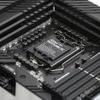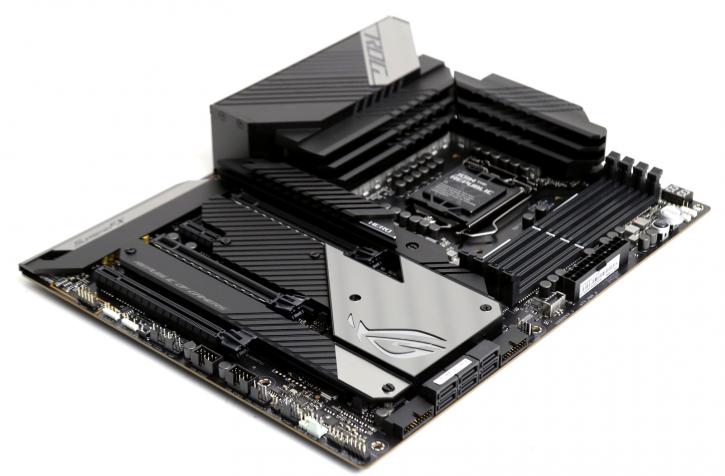Final Words & Conclusion
Final words & conclusion
Granted, I have a soft spot for the HERO series; however, ASUS made some ominous changes compared to the Z490 model. While increasing the price seen from the Z490 HERO, ASUS stripped the OLED display, removed 5 Gbps Ethernet LAN, however, applied a duo of 2.5 Gbps jacks. In return, however, you get thunderbolt 4 supported, which does bring in a bit more value; then again, at 469 USD/EUR, I am reluctant to use the word value. The thing is, the Z490 model, in some ways, is superior to the Z590 model in some ways whilst being somewhat cheaper. And yes, the latest BIOS for the Z490 model also offers PCIe Gen 4.0 support. So yeah, how relevant the Z590 platform over Z490 really remains a trivial debate. Most Z490 motherboards will be PCIe 4.0 compatible (with Rocket-Lake) after a firmware upgrade. The leaves as the difference an x8 lane uplink from chipset towards the CPU and vice versa, as well as USB gen 3.2. The differences end there, though. ASUS did add four M2 slots; however, one can be connected directly to the CPU at 4x lanes would offer full Gen 4.0 x4 bandwidth. The ones connected through the Z590 chipset are PCIe Gen 3.0 based (for me, no biggy, though). Priced at 469 USD, where is the rest of the value, you might wonder? Well, the motherboard certainly has a powerful VRM design backed by 90A stages. The VRM area with a 11900K under stress remains just under 60 Degrees C. FLIR imaging backs up minimal heat bleed. ASUS added a WIFI6E (AX) solution, which may not be forgotten.
DDR4 memory
For Rocket Lake-S and 10th Gen Intel procs) and DDR4, we always say, volume matters more than frequency. A 3200 CL16 to 3600 CL18 MHz kit is fast enough overall for all your needs. Higher frequency memory is more expensive and does offer better bandwidth, but the performance increase in real-world usage will be hard to find. Unless you transcode videos over the processor a lot, as always, my advice would be to go with lower clocked DDR4 memory with decent timings, but get more of it. Don't go for 8 GB; get two or four DIMMs, and in total, a minimum of 16 GB. We think the current sweet spot is 3200 MHz (CL14/CL16) or 3600 MHz CL16/CL18).
Performance & tweaking
Temps/TDP remains icky to judge but is manageable when you apply proper LCS. We recommend the same for the more high-end Ryzen 5000 processors as both brands benefit from that nicely chilled heat spreader. At the OC levels for RKL, you are looking at 1.35V and higher needed on that CPU core for a decent tweak; however, pretty similar for AMD, tweaking 8-core or higher processors is more difficult as you are bound to run into core limitations, heat, and there it is again .. power consumption. At 5300 MHz / v1.53, we're passing 450 Watts. That's not sane. All core 5200 MHz / 1.43V draws 410 Watts (PC just CPU under load). With a processor that already runs in that 5 GHz domain, you also need to wonder if you want to tweak it at all, as really, the best configuration is already there at defaults. Regardlessly, if you like to do so, LCS will probably get you to 5.2~5.3 GHz (all cores) depending on ASIC quality, cooling, mobo, and power supply. Tweaking wise you increase the CPU voltage and multiplier, and you are good to go. Another plus for the Intel platform is that over the years, they have been able to refine their memory controllers, pop in anything XMP 2.0, and you have a 98% chance it'll work straight out of the box with high-speed memories. However, the effect of speedier frequency memory is far less significant, so opt volume would be my advice. We'd always suggest going with a nice affordable 3200 or a 3600 MHz kit at low latencies. Currently, we feel 3600 Mhz is the new norm and sweet-spot, though. The infrastructure that Z590 offers is sound and has proven to be reliable and easy to use. But if pricing is a thing, I'd even recommend you Z490 over Z590.
Power consumption
With eight cores, you get a 125 Watt TDP processor. But as explained, it all is a little more complicated these days. Intel applies a secondary power stage where the processor can run twice the TDP value for a pretty long time. That with the IPC increase, Cypress cove cores get the holy grail for added threading performance; however, it makes energy consumption peak with higher values during that long boost. The idle system with a GeForce RTX 3090 installed / 16 GB memory / SSD and the Z590 motherboard hovers at roughly 70~80Watts. That's okay, really, but the load values are significantly different. When we stressed the processor 100% run, we reach approximately 300 Watts with this 8-core processor (for the entire PC with GPU in idle).
Conclusion
Honestly, if you asked me on the spot what I would buy, the Z490 HERO or the Z590 HERO ... I would not know the answer immediately. Personally, I have little use for Thunderbolt, and the Z490 model does offer a 5 GigE LAN jack (2.5GigE on the Z590), as well as you now miss out on the small OLED screen. The differences otherwise are trivial at best. With a price tag hovering in the 450~500 USD range, this board is out of my comfort zone. It does offer four M2 slots, six SATA3 slots, AX WIFI6E, and a duo of 2.5 GigE LAN jacks. We would have liked to see the latter replaced by a 5 or 10 GigE jack at this price level. Of course, we should not forget to mention the motherboard has Thunderbolt 4. Armed with a Rocket Lake proc, Intel brings the platform much-desired PCIe Gen 4.0 lanes, of which four you can utilize for a super-fast NVMe SSD. Aside from double DMI link bandwidth and USB 3.2 Gen 2x2 (SuperSpeed USB 20Gbps), there is little gain from Z590 overall. A multitude of Z490 motherboards will even support PCIe Gen 4.0 after a BIOS update (Gen 11 proc mandatory). How important the rest is to you is for you to decide. VRM wise we can't complain at all, you can tweak as far as your proc can go, but with the power signature of Rocket-lake and the corresponding thermals, you'll likely reach something close to 5200~5300 MHz on all cores but will need to arm yourself with a kilowatt PSU and really proper cooling. In the end, the new HERO isn't a HERO, but more of the same at a high price level. It has some delightful BIOS features, though, and is a pleasure to work with. We had no stability issues or anything weird whatsoever. The board is feature-packed has good aesthetics, proper performance, and overclocking options. But this all comes delivered at a hefty price tag. If you find it worth the price tag, recommended, of course.
Handy related downloads:
- Sign up to receive a notification when we publish a new article
- Or go back to Guru3D's front page.



